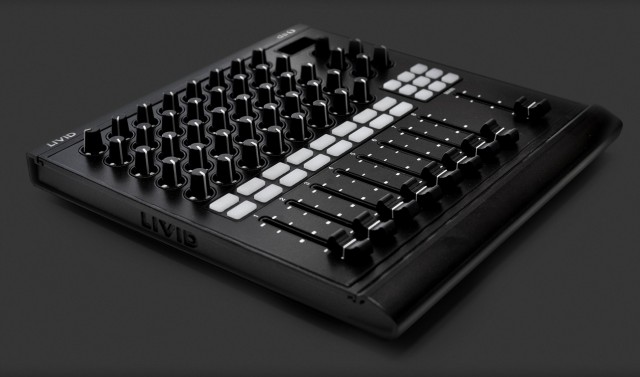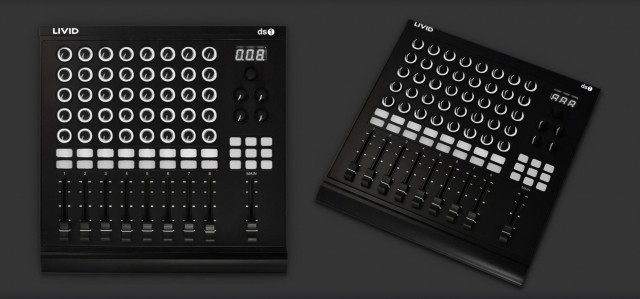We’ve got grids, more grids, and disco grids. We’ve got fake platters and big, whirling plates. We’ve got iPads and things you wave around in the air. But as controllers have embraced digital design, the number of controllers that have the logical layout of a mixer has, remarkably, diminished.
And what really don’t have much of is a controller that’s truly DAW-agnostic. Integration is great, but you need hardware for people who don’t believe in One Tool as religion.
It’s taken New York-based learning center Dubspot to reignite that idea, in a controller collaboration with Dave Cross and Livid Instruments. The DS1 is sleek, clad in all-black, free of extraneous flashing lights and logos and labels. Instead, what you get is a whole bunch of knobs and faders, arrayed as you’d expect them to be on a mixer. They could be the console for digital mixing in the laptop – where a lot of you do it anyway – or simply a more-rational layout for control for anything else. (Visualists, too, I imagine will be pleased.)
And Dubspot isn’t just getting into the hardware sales business. The first thing they say in their press release is that they couldn’t find a single controller that did this kind of mixing for the student workstations in New York (and opening in LA).
It’s not hard to see this alongside a Maschine or Push, for instance, with each of those lacking in mixing. But that’s just the beginning.
First, the specs, from the source:
9 high-quality, 60mm faders
44 rotary knobs with single-color backlighting
1 push encoder
25 RGB buttons
Class-compliant MIDI USB
Expression pedal input (compatible with the Livid Master Fader) Ultra light and heavy-duty aluminum construction
I also had a chat with long-time friend-of-the-site Dave Cross, who’s now brought his controller expertise to Dubspot.
What’s availability or pricing going to be on DS-1 – or have you announced that yet?
Still mostly TBD. We want to shoot for production in a few months, pricing under $500USD.
Sorry to not be more specific, those details simply haven’t been sorted yet. I will be parading a real prototype around the show though. These are NOT renders.
Tell us a little bit about what went into the design process. First, I understand these were really designed around the teaching process. What does that mean, specifically? Why this particular layout? (And did that also come from feedback with Dubspot?)
The Dubspot layout feedback basically was the design process. There’s more feedback we need to provide on knob pressure, fader smoothness and knob cap choice, but the layout was key.
We need to teach universal concepts that are agnostic to any DAW. We’re not trying to just teach software operation, we’re trying to teach creativity. The universal paradigm for mixing tracks is the mixer. The DAW mixing control surface is a product category in itself, but it wasn’t a good fit. We needed something simpler.
I’m dribbling: basically the Dubspot Teaching Process is based on DAW-agnostic pure creativity. The products on the market that attempted some level of universal feature set with DAW-agnosticism weren’t… agnostic enough for our needs. So we built our own.
What was it like working with Livid, and is there any relationship to other Livid units?
There is no other relationship to Livid units. We knew they were game for this kind of collaboration because we’ve been friendly for years. Richie Hawtin’s CNTL:R was proof that they actively collaborate, and the Alias 8 was close enough to our goals to convince us they’d be game for our design.
Working with Livid has been super-cool. They’re laid back while still getting shit done. I’m guessing that’s Austin in a nutshell, what with it’s melting pot of go-getters around the US.
I imagine we’ll see some fairly active mapping from you guys – any particular plans?
Yeah. We wanna go a bit nuts with that. Mappings to suit each main program, built around our star Teachers and Course Designers. It’s great cross-promotion.
The buttons – no velocity sensitivity, just switches, but above the mixer strips and then in the grid on the right? Yes? And you can send RGB as MIDI I hope?
Correct, they’re not intended to be drum pads by any stretch of the imagination. Fully extensible with Livid’s firmware, so the intention will be easy MIDI-responsive coloration.
Thanks, Dave. We will of course be following this story as it evolves, as we’re keen to do stuff with this controller, too.

